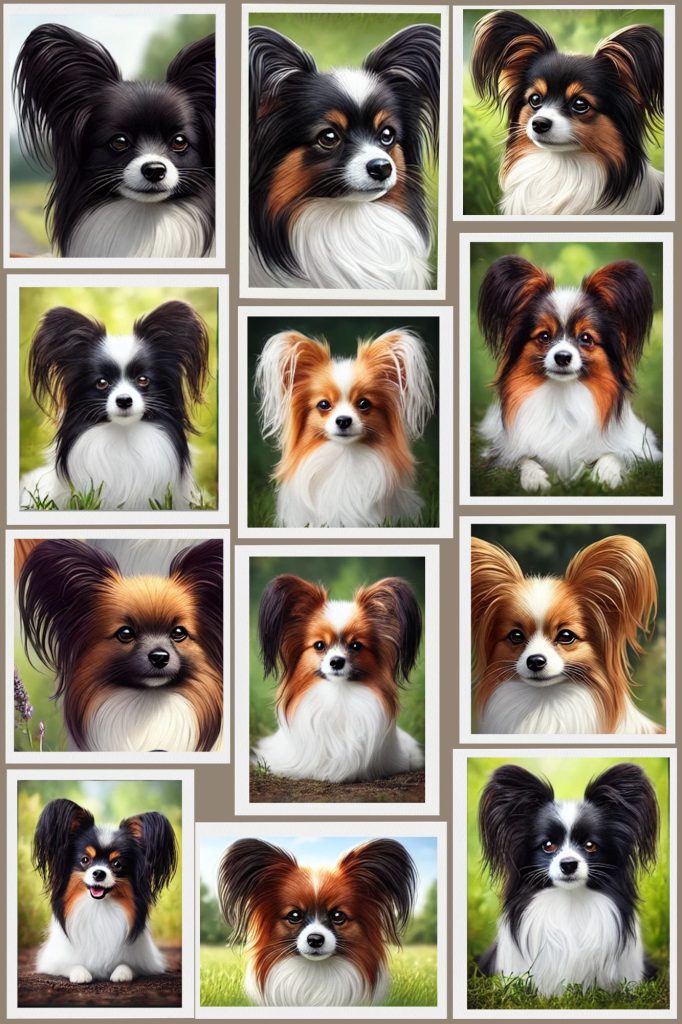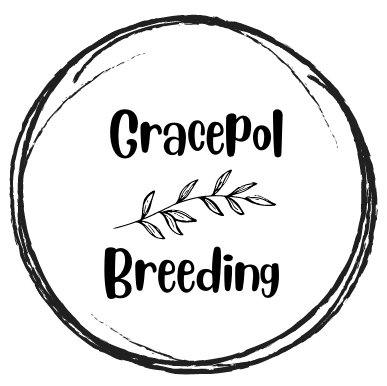A Comprehensive Overview
The Papillon is a small, intelligent, and friendly toy breed, known for its distinctive butterfly-like ears, from which it gets its name (“Papillon” means butterfly in French). Originating in Europe, the Papillon has been cherished as a companion dog for centuries and remains popular for its versatility, agility, and affectionate nature.
Coat Colors
The Papillon comes in a variety of beautiful colours, always accompanied by a predominantly white coat:
– Black and White
– Tri-colour (varying shades of the tan pips, from deep red to pale lemon)
– Red, Black and White (varying shades of red to pale yellow)
– Sable and White
– Red and White (Very uncommon)
– Lemon and White (Very rare)

Papillons have a fine, silky, single-layer coat, which contributes to their elegant and refined appearance.
Temperament
Papillons are known for their lively, intelligent, and friendly nature. Despite their small size, they are bold, confident, and highly trainable. Here are some common temperament traits:
– Affectionate and friendly: Papillons are deeply affectionate and form strong bonds with their owners. They are social dogs that love to be involved in family activities and are good with children and other pets.
– Alert and intelligent: Papillons are known for their sharp minds and quick learning abilities. They make excellent watchdogs, often alerting their owners to changes in their surroundings, but they are not aggressive. Their intelligence also makes them excellent candidates for dog sports such as agility, obedience, and rally.
– Playful and energetic: Despite their delicate appearance, Papillons are active dogs that enjoy exercise and play. They are quick, agile, and love running, making them suitable for activities like agility and even flyball. Their playful and inquisitive nature means they need regular mental stimulation.
– Trainable but independent: Papillons are highly trainable, often excelling in obedience competitions. However, like many small dogs, they can sometimes display an independent streak. Positive reinforcement and consistent, patient training work best with this breed.
– Curious and adventurous: Papillons are not typically shy or timid. They are curious and adventurous, always eager to explore new environments. Their small size allows them to adapt easily to various living situations, whether it’s a city apartment or a rural home.
Care and Grooming
Papillons are relatively low-maintenance when it comes to grooming, though they do require regular care to keep their coat and health in top condition:
– Exercise: Papillons, despite their small size, are energetic dogs that need daily exercise. Playtime, walks, and even agility training can help keep them both mentally and physically fit.
– Grooming: Papillons have a fine, silky coat that doesn’t mat easily, but regular brushing (about twice a week) will keep it smooth and shiny. They don’t have an undercoat, which makes grooming easier, but care should be taken to keep their ears clean and free of debris.
Health in Papillons
Papillons are generally healthy dogs, but like all breeds, they are prone to certain health issues. Here are the key health concerns to be aware of:
– Patellar Luxation: This is a common condition in smaller dogs where the kneecap can slip out of place, causing discomfort or lameness. In severe cases, surgery may be required, but many cases are manageable with care.
– Progressive Retinal Atrophy (PRA): PRA is an inherited condition that can lead to blindness. Responsible breeders test their dogs to reduce the risk of this condition in their puppies.
– Dental issues: Papillons, like many toy breeds, can be prone to dental problems. Regular dental care, including brushing and professional cleanings, is important to maintain their oral health.
– Collapsed trachea: A condition in smaller breeds, this occurs when the rings of cartilage in the trachea weaken, leading to difficulty breathing. It is often manageable with medication and weight control.
Fun Facts About Papillons
– Butterfly ears: The name “Papillon” means “butterfly” in French, which refers to their distinctive ears that resemble the wings of a butterfly. Papillons with upright ears are called “Papillons,” while those with dropped ears are known as Phalenes (meaning “moth” in French).
– Tiny dogs with big brains: Despite their small size, Papillons are one of the most intelligent dog breeds. They consistently rank high in obedience and agility competitions due to their quick learning ability and eagerness to please.
– One of the oldest toy breeds: Papillons have been depicted in European art as early as the 16th century. They were popular among royals, including France’s Marie Antoinette, who reportedly adored her Papillon named “Thisbé.”
– Tiny but mighty: Papillons may be toy-sized, but they are energetic and love to be active. They are known for excelling in dog sports like agility, rally, and obedience, where they can run through courses at lightning speed.
– Loyal lapdogs: Historically, Papillons were bred as companion dogs for European nobility. While they are playful and lively, they love curling up in their owner’s lap for some cuddle time, making them the perfect combination of playful and affectionate.
– Surprisingly durable: Papillons are hardy dogs for their size. While they are delicate-looking, they are sturdy, healthy dogs with good longevity, often living 12 to 16 years or more with proper care.
Conclusion
The Papillon is a small dog with a big personality. Their affectionate nature, combined with their intelligence and energy, makes them ideal companions for both families and individuals. Despite their delicate appearance, they are hardy and active dogs, capable of excelling in various roles, from companion to competitor in dog sports.
With their distinctive butterfly ears, playful demeanour, and friendly nature, Papillons are a joy to have as pets. Their small size makes them adaptable to various living environments, but they thrive best when given plenty of attention, mental stimulation, and love.
